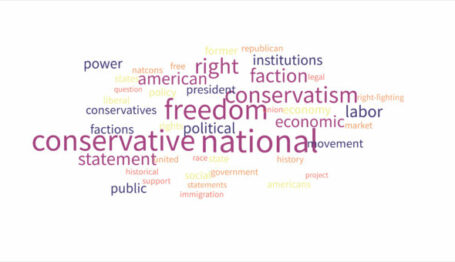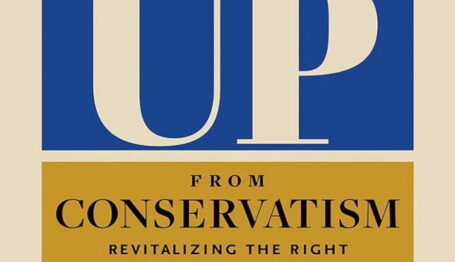Special Report
On the Question of Right Fights: Postliberals for American Liberalism


On the Question of Right Fights (full series)
Factions on the Right | Dueling Manifestos
National Conservatism at Arms | Postliberals for American Liberalism
“Grill Dad Republican”
Postliberals for American Liberalism: Tyranny, Inc.
Sohrab Ahmari’s Tyranny, Inc. is not the “manifesto” of the Postliberal-Integralist faction; that would more accurately describe Patrick Deneen’s Regime Change. But Ahmari provides a glimpse into the motivations and prescriptions that faction would bring about if given power. And, perhaps oddly for a faction attempting to call itself “postliberal,” those prescriptions are proudly liberal in the American sense.

Ahmari is correct to note that economic markets, especially the labor market, are not completely free in the economic modeler’s or libertarian philosopher’s sense. As Kipling wrote, “the Gods of the Copybook Headings said: ‘If you don’t work you die.’” But the presence of some coercion in markets does not redeem Ahmari’s erroneous analyses or state-socialist conclusions, which rely on three pervasive errors. Ahmari’s economic story misses key elements of contemporary American and Western economic history, his labor history is effectively AFL-CIO institutional propaganda, and his analysis of institutions including the conservative Right that he hopes to replace is riddled with wishful thinking.
Ahmari praises the central planning regimes that united Big Government, Big Business, and Big Labor during World War II, crediting them with creating the consumer society of the 1950s that his tome idolizes as the ideal political economy. But were that true, the United Kingdom under the government of Clement Attlee, which socialized most of the “commanding heights” of its midcentury economy—railways, coal mining, and most famously health care, among other industries—should have had more of the consumer society than the decadent capitalist Americans. It didn’t. In fact, the controlled economy of immediately postwar Britain was even more restricted than its wartime economy, and it took Winston Churchill’s return to power in 1951 to end food rationing.
What all factions seeking a “retvrn” to the midcentury political economy all seem to forget is that the 1950s had a secret sauce keeping factories humming and the economy moving. President Dwight Eisenhower even gave it a catchy name: the “military-industrial complex.” World War II military spending got the country out of the Depression, and postwar economic booms were powered by literal (atomic) booms as well. From the end of the Korean War through President Ronald Reagan’s election in 1980, defense spending as a share of GDP typically sat at about 8 percent of GDP and never dipped below 4.5 percent. (In the early 2020s, it is about 3.5 percent.) On top of this gigantic military-industrial complex, World War II had reduced America’s economic partners and rivals to rubble or subjected them to Communism, making American industry effectively the only game in town.
The political-economic story that Reagan created a discontinuous cleavage from a Truman-Ike-LBJ-Nixon consensus is contested and probably wrong. While the initial New Deal programs were relatively popular, extending them was less so, and the New Deal coalition broke down as early as 1938 when the Southern Democrats held the balance of congressional power. And Eisenhower and Nixon proved to be less Continuing Revolutionaries in the New Deal–Great Society mold (which some on the Republican Right feared they, especially Eisenhower, might become) than small-c conservatives.
Deepening his errors of economic history, Ahmari suggests that the “stagflation” of the 1970s was “but a blip.” His implication from that claim is that the policies adopted during and following the governments of Ronald Reagan in the United States and Margaret Thatcher in Great Britain were just favors to business supporters who exploited a political opportunity to reverse the “thirty glorious years” of socialist planning following the World War.
But the economic miasma that affected the United States and Great Britain in the late 1970s was so widespread that countries across the democratic West joined the U.S. and U.K. in economic liberalization. France’s Socialist leader of the 1980s, Francois Mitterand, was not able to extend the Thirty Glorious Years with more (and deeper, as he was the first outright left-winger to lead France since the country adopted its Fifth Republic constitution) socialism. The Nordic model is no longer state socialism; over the period Ahmari condemns, the Nordics adopted wide-open market economies appended to very-high-middle-class-tax welfare states. Canada reformed its old-age pensions under a Liberal Party government in the 1990s. India, while admittedly not “Western,” ditched its infamous state-socialist License Raj. Were they all comically evil, or manipulated by the conniving of a mild-mannered, five-foot-nothing academic?
At least Japan tried to save its state-managed economy. But that led not to another 30 glorious years, but Three Lost Decades. There was, as the slogan credited to Margaret Thatcher said, no alternative to market-focused reform.
Tyranny, Inc.’s labor history is as propagandistic as its economic history. Ahmari seeks a return to the logic of the original Wagner Act, which he claims explicitly promoted unionism. Interestingly, the law’s sponsor, Sen. Robert Wagner (D-NY), repeatedly affirmed that coercing workers to join unions was not his intention during legislative debates, which may have been deception. But if it was deception, Wagner’s reliance on it speaks to a political reality—coercion by labor unions is not popular in the American context.
After it went into effect, the original Wagner Act was reformed for a reason. Once the WWII-era labor pacts devolved into the 1945–46 strike wave and attendant economic crisis, the public demanded what would later become the bipartisan Taft-Hartley Act restrictions on secondary boycotts, its reciprocal mandate to good-faith bargain, and its placement of coercive acts by unions under federal regulatory jurisdiction. These were all direct responses to recognized abuses encouraged by the original Wagner Act. (This is to say nothing of Taft-Hartley’s limitations on the closed shop and other practices to coerce union membership.)
The Wagner Act system had also created a vehicle for the organized crime takeover of major unions. One cannot address American labor history without grappling with James Riddle Hoffa. As a result, even the supposed New Dealer Dwight Eisenhower had to pass (with the assistance of such figures as Sen. Jack Kennedy (D-MA) and his staffer brother Bobby) the Labor Management Reporting and Disclosure Act to do something about it.
As one-sided as Ahmari’s historical analyses are, they pale in comparison to his bad institutional analysis, which begins before the narrative proper, when Ahmari takes Amazon Labor Union president (and controversial figure within the labor movement) Christian Smalls at his word. Allowed to control policy, Ahmari’s labor unionism would collide violently into his social conservatism, since labor union officers and staffers, like those of the Amazon Labor Union, are staunchly radical in their social views and support politicians who would make those radical views law.
Ahmari’s institutional naivety is illustrated by his praise for Report for America as a savior of local journalism. A perusal of Report for America’s funders, helpfully compiled by CRC’s InfluenceWatch, shows it to be a who’s who of Big Liberal Philanthropy and Big Tech’s corporate giving arms, including Google News Lab and Facebook Journalism Project. A conservative should question the agenda of such an institution, as surely as he would question the agenda of the old not-really-objective local dailies that printed AP stories and published liberal columnists, like the Ahmari-mentioned Virginian-Pilot.
Finally, one must ask what political-right Ahmari thinks America has, anyway? Institutions affiliated with entrepreneurs and small businesses (the National Federation of Independent Business, International Franchise Association, even at times local and national Chambers of Commerce) side with social conservatives in electoral combat. Organized labor opposes social conservatism on all fronts and shows no sign of changing allegiance.
In the next installment, right-fighting on all sides ignores the ordinary conservative voter.



